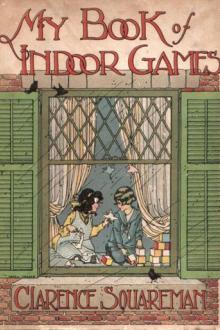My Book of Indoor Games by Clarence Squareman (top novels to read .txt) 📖

- Author: Clarence Squareman
- Performer: -
Book online «My Book of Indoor Games by Clarence Squareman (top novels to read .txt) 📖». Author Clarence Squareman
Next comes the word "Pipe," and this must be brought in in the same manner. When you have acted the two syllables, you must act the whole: "Bagpipe."
Before beginning the charade, you should arrange who is to bring in the charade word or syllable. You must also settle what you are going to say, or at least, what the act is to be about. Let every scene be well thought out and be as short as possible. You must be as quick as ever you can between the acts, for all the fun will be spoiled if you keep your audience waiting. If you have no curtain or screen, the actors must simply walk off the stage at the end of the scenes.
To act charades well, one requires a little practice and plenty of good temper, for, of course, only one or two can take principal parts, and therefore some of the children must be content to take the smaller ones. It is a good plan to take it in turns to play the best parts, and if the elder children are kind and thoughtful, they will try to make some easy little parts, so that their younger brothers and sisters may also join in the fun. Here we give you a very simple charade, the words of which you may learn, and then act, after which you will very likely be able to make up charades for yourselves.
The "Band-Box" Charade Scene 1: A StreetThis can be made by placing a row of chairs with open backs near the wall facing the audience; a child is stationed behind each chair, and, looking through the open back, pretends to be looking out of a window.
BANDFirst Child behind chair.—Oh! dear, how dull our street always is. I declare nothing nice ever comes this way.
Second Child.—No, I quite agree with you. Why, I haven't seen a "Punch and Judy" for months. I wish my mother would go and live in another street.
Third Child.—Never mind, let us go out and have a game.
(Enter five or six children—or a lesser number, if more convenient—carrying toy musical instruments.)
First Child.—Hurrah! Here comes a German band. Come along, children; let's go and listen to it.
(The band groups itself at the end of the street, and the children stand round. After tuning up, the band begins to play.)
Second Child.—Now, Mary Jane, we can dance. I'll dance with you.
Third Child.—No, I want to dance with Mary Jane.
First Child.—I don't want to dance at all.
Second Child.—You must.
Third Child.—Yes, you must.
(Band ceases playing and one of the bandsmen comes round for money.)
First Child.—I haven't any money.
Second Child.—But we haven't begun to dance yet.
Bandsman.—You shouldn't have been so long arguing then. Surely you'll give the band a nickel, after all the pretty music it has played?
First Child.—I won't.
Second Child.—I won't.
Third Child.—And I won't.
Bandsman.—Well, you are mean. Come along. (Beckoning to the rest of the band.) We'll go, and it will be a long time before we come down this street again.
Tommy (hopping about the room, waving a letter in his hand.)—Hurrah! hurrah! Uncle Dick is coming. Hurrah! hurrah!
(Enter Tommy's brother and sister and papa and mamma.)
Papa.—What's the matter, Tommy?
Tommy.—Uncle Dick has written to say he is coming to spend Christmas with us, and he is bringing me a Christmas box.
Mamma.—How kind of him! But be sure you are careful not to offend him, Tommy. He is rather a touchy old gentleman.
Sister.—I wonder what it will be, Tommy.
Brother.—I hope it will be a set of cricket things, and then we can play cricket in the summer.
Tommy.—Oh! yes, I hope it will be, but whatever it is, it is sure to be something nice.
(Begins hopping about again. Enter Uncle Dick, a very old gentleman with a gouty foot. Tommy does not see him and goes banging into him, treading on his gouty foot.)
Uncle Dick.—Oh! oh! oh! oh, my toe!
Tommy.—Oh! Never mind your toe! Where's my Christmas box?
Uncle Dick.—Your Christmas box, you young scamp! Think of my toe.
Tommy.—Please, uncle, I'm very sorry, but I do so want to know what you have brought me for a Christmas box.
Uncle Dick (roaring).—Here's your Christmas box, and may it teach you to be more careful in future. (Boxes Tommy's ears.)
Here is a list of words which will divide easily into charade words:
Brides-maids. Sea-side. Car-pen-try.
Cur-tail. Nose-gay. In-do-lent.
Hand-i(I)-craft. Turn-key. Hand-some.
Key-hole. Rail-way. Sweet-heart.
Port-man-teau(toe). Mad-cap. A-bun-dance.
In-no-cent. Fox-glove. Pat-riot.
To make your charades a real success, you will, of course, require a curtain. A very effective one can be made with a little trouble and at a small cost; indeed, the materials may be already in the house.
First you must fix a couple of supports on each side of the room, taking care that they are screwed firmly into the wall, and also taking care not to damage the paper.
If you are a neat workman, you will find on taking out the screws that the two small screw-holes on each side will scarcely be noticed, as of course the supports must be fixed near the ceiling.
You must then put up your curtain-pole, which should be as thin as possible, so that the rings may run easily. A cheap bamboo pole is the best.
Two wide, deep curtains are required; very likely the nursery curtains may be suitable.
On to these curtains you sew a number of small brass rings, which you can buy for about 20 cents a dozen, or even less. The rings should be sewn on the curtains, as you see in the illustration, right across the top, and from the extreme top corner of the curtain, slantingwise across to the middle.
The top rings are passed along the curtain-pole, a string (marked in the illustration A1) is sewn on to the curtain, and threaded through the rings until it reaches A2. It is then threaded through the rings on the pole until it reaches A3, when it is allowed to fall loose.
The same arrangement is gone through with string B. The bottom of the curtain must be weighted with shot, or any other weights that may be convenient.
When the curtain is to be raised, the stage manager and his assistant stand on each side of the stage with the strings ready in their hands, and at a given signal—the ringing of a bell is the usual sign that all is ready—they each pull a string, and the curtains glide to each side, and may be fixed to hooks, put up on purpose.
When the curtain is to fall, the two in charge of it must simply loosen the strings and let them go, and the weights cause the curtains to fall to the center.
All sorts of useful and ornamental "properties" may be made at home for a very small cost. Cardboard, and gold and silver paper, and glue go a long way toward making a good show.
Swords, crowns, belts, gold-spangled and gold-bordered robes can be made from these useful materials, and look first-rate at a distance.
An old black dress with little gold stars glued or gummed to the material would make an excellent dress for a queen. The swords or belts must first be cut out in cardboard, then covered with gold or silver paper.
To make a good wig, you should shape a piece of calico to fit the head; then sew fire shavings or tow all over it. If you wish for a curly wig, it is a good plan to wind the shavings or tow tightly round a ruler, and tack it along with a back stitch, which will hold the curl in position after you have slipped it off the ruler. These few hints will give you some idea of the very many different costumes which can be made by children out of the simplest materials.
The person who is to play the part of Cat should stand outside the door of the room where the company is assembled. The boys and girls, in turn, come to the other side of the door and call out "miaou." If the Cat outside recognizes a friend by the cry, and calls out her name correctly in return, he is allowed to enter the room and embrace her, and the latter then takes the place of Cat. If, on the contrary, the Cat cannot recognize the voice, he is hissed, and remains outside until he does.
Living pictures are very amusing if well carried out, and even with little preparation may be made very pretty or very comical, whichever may be desired. It is perhaps better to attempt comical ones if you have not much time in which to arrange them, as the costumes are generally easier to manage, and if you are obliged to use garments not quite in keeping with the characters, it does not matter much; indeed, it will probably only make the audience laugh a little more.
The great thing in living pictures is to remain perfectly still during the performance. You should select several well-known scenes either from history or fiction, and then arrange the actors to represent the scenes as nearly as possible.
Simple home living pictures are a great source of fun, and many a wet afternoon will pass like magic while arranging scenes and making dresses to wear. Newspaper masks, newspaper cocked hats, old shawls, dressing-gowns, and sticks are quite sufficient for home charades.
Suppose, for instance, you think of "Cinderella" for one tableau. One girl could be standing decked out with colored tissue paper over her frock, and with paper flowers in her hair, to represent one of the proud sisters, while Cinderella in a torn frock is arranging the other proud sister's train, which may consist of an old shawl. Bouquets of paper flowers should be in the sister's hands.
"Little Red Riding Hood" is another favorite subject for a living picture. The wolf may be represented by a boy on his hands and knees, with a fur rug thrown over him. Red Riding Hood only requires a scarlet shawl, arranged as a hood and cloak, over her ordinary frock and pinafore, and she should carry a bunch of flowers and a basket.
All living pictures look better if you can have a frame for them. It is not very difficult to make one, especially if you have four large card-board dress-boxes.
Having carefully cut out the bottoms of the boxes, place the frames as here shown:
Cut out the center framework, leaving a large square, so:
You must then fasten the four pieces together by gluing cardboard on each side of the joints, and you will have a very good frame, which you can cover with colored paper or ornament with muslin.
This frame will last a very long time if carefully treated. It should stand upright by itself; but if it is a little unsteady, it is better to hold it upright from the sides. Of course, this will only make a very small frame, but you can increase the size by using more boxes.
If you have no time to make a frame, arrange your figures close to a door, outside the room in which the audience is seated.
When quite ready, some one must open the door, when the doorway will make a kind of





Comments (0)